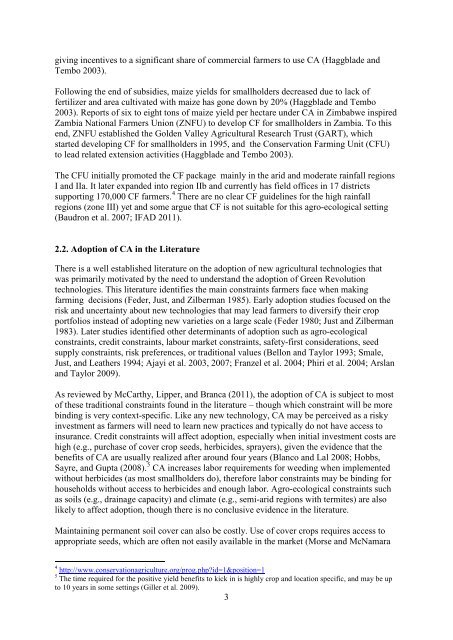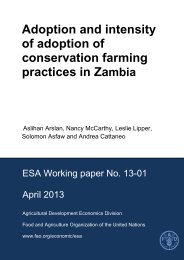Adoption and intensity of adoption of conservation farming practices in Zambia
Adoption and intensity of adoption of conservation farming practices in Zambia
Adoption and intensity of adoption of conservation farming practices in Zambia
Create successful ePaper yourself
Turn your PDF publications into a flip-book with our unique Google optimized e-Paper software.
giv<strong>in</strong>g <strong>in</strong>centives to a significant share <strong>of</strong> commercial farmers to use CA (Haggblade <strong>and</strong><br />
Tembo 2003).<br />
Follow<strong>in</strong>g the end <strong>of</strong> subsidies, maize yields for smallholders decreased due to lack <strong>of</strong><br />
fertilizer <strong>and</strong> area cultivated with maize has gone down by 20% (Haggblade <strong>and</strong> Tembo<br />
2003). Reports <strong>of</strong> six to eight tons <strong>of</strong> maize yield per hectare under CA <strong>in</strong> Zimbabwe <strong>in</strong>spired<br />
<strong>Zambia</strong> National Farmers Union (ZNFU) to develop CF for smallholders <strong>in</strong> <strong>Zambia</strong>. To this<br />
end, ZNFU established the Golden Valley Agricultural Research Trust (GART), which<br />
started develop<strong>in</strong>g CF for smallholders <strong>in</strong> 1995, <strong>and</strong> the Conservation Farm<strong>in</strong>g Unit (CFU)<br />
to lead related extension activities (Haggblade <strong>and</strong> Tembo 2003).<br />
The CFU <strong>in</strong>itially promoted the CF package ma<strong>in</strong>ly <strong>in</strong> the arid <strong>and</strong> moderate ra<strong>in</strong>fall regions<br />
I <strong>and</strong> IIa. It later exp<strong>and</strong>ed <strong>in</strong>to region IIb <strong>and</strong> currently has field <strong>of</strong>fices <strong>in</strong> 17 districts<br />
support<strong>in</strong>g 170,000 CF farmers. 4 There are no clear CF guidel<strong>in</strong>es for the high ra<strong>in</strong>fall<br />
regions (zone III) yet <strong>and</strong> some argue that CF is not suitable for this agro-ecological sett<strong>in</strong>g<br />
(Baudron et al. 2007; IFAD 2011).<br />
2.2. <strong>Adoption</strong> <strong>of</strong> CA <strong>in</strong> the Literature<br />
There is a well established literature on the <strong>adoption</strong> <strong>of</strong> new agricultural technologies that<br />
was primarily motivated by the need to underst<strong>and</strong> the <strong>adoption</strong> <strong>of</strong> Green Revolution<br />
technologies. This literature identifies the ma<strong>in</strong> constra<strong>in</strong>ts farmers face when mak<strong>in</strong>g<br />
<strong>farm<strong>in</strong>g</strong> decisions (Feder, Just, <strong>and</strong> Zilberman 1985). Early <strong>adoption</strong> studies focused on the<br />
risk <strong>and</strong> uncerta<strong>in</strong>ty about new technologies that may lead farmers to diversify their crop<br />
portfolios <strong>in</strong>stead <strong>of</strong> adopt<strong>in</strong>g new varieties on a large scale (Feder 1980; Just <strong>and</strong> Zilberman<br />
1983). Later studies identified other determ<strong>in</strong>ants <strong>of</strong> <strong>adoption</strong> such as agro-ecological<br />
constra<strong>in</strong>ts, credit constra<strong>in</strong>ts, labour market constra<strong>in</strong>ts, safety-first considerations, seed<br />
supply constra<strong>in</strong>ts, risk preferences, or traditional values (Bellon <strong>and</strong> Taylor 1993; Smale,<br />
Just, <strong>and</strong> Leathers 1994; Ajayi et al. 2003, 2007; Franzel et al. 2004; Phiri et al. 2004; Arslan<br />
<strong>and</strong> Taylor 2009).<br />
As reviewed by McCarthy, Lipper, <strong>and</strong> Branca (2011), the <strong>adoption</strong> <strong>of</strong> CA is subject to most<br />
<strong>of</strong> these traditional constra<strong>in</strong>ts found <strong>in</strong> the literature – though which constra<strong>in</strong>t will be more<br />
b<strong>in</strong>d<strong>in</strong>g is very context-specific. Like any new technology, CA may be perceived as a risky<br />
<strong>in</strong>vestment as farmers will need to learn new <strong>practices</strong> <strong>and</strong> typically do not have access to<br />
<strong>in</strong>surance. Credit constra<strong>in</strong>ts will affect <strong>adoption</strong>, especially when <strong>in</strong>itial <strong>in</strong>vestment costs are<br />
high (e.g., purchase <strong>of</strong> cover crop seeds, herbicides, sprayers), given the evidence that the<br />
benefits <strong>of</strong> CA are usually realized after around four years (Blanco <strong>and</strong> Lal 2008; Hobbs,<br />
Sayre, <strong>and</strong> Gupta (2008). 5 CA <strong>in</strong>creases labor requirements for weed<strong>in</strong>g when implemented<br />
without herbicides (as most smallholders do), therefore labor constra<strong>in</strong>ts may be b<strong>in</strong>d<strong>in</strong>g for<br />
households without access to herbicides <strong>and</strong> enough labor. Agro-ecological constra<strong>in</strong>ts such<br />
as soils (e.g., dra<strong>in</strong>age capacity) <strong>and</strong> climate (e.g., semi-arid regions with termites) are also<br />
likely to affect <strong>adoption</strong>, though there is no conclusive evidence <strong>in</strong> the literature.<br />
Ma<strong>in</strong>ta<strong>in</strong><strong>in</strong>g permanent soil cover can also be costly. Use <strong>of</strong> cover crops requires access to<br />
appropriate seeds, which are <strong>of</strong>ten not easily available <strong>in</strong> the market (Morse <strong>and</strong> McNamara<br />
4<br />
http://www.<strong>conservation</strong>agriculture.org/prog.php?id=1&position=1<br />
5<br />
The time required for the positive yield benefits to kick <strong>in</strong> is highly crop <strong>and</strong> location specific, <strong>and</strong> may be up<br />
to 10 years <strong>in</strong> some sett<strong>in</strong>gs (Giller et al. 2009).<br />
3



